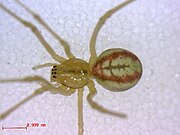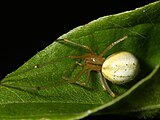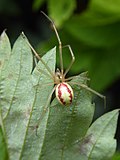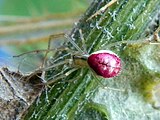| Enoplognatha ovata | |
|---|---|

| |
| Female | |
| Scientific classification | |
| Domain: | Eukaryota |
| Kingdom: | Animalia |
| Phylum: | Arthropoda |
| Subphylum: | Chelicerata |
| Class: | Arachnida |
| Order: | Araneae |
| Infraorder: | Araneomorphae |
| Family: | Theridiidae |
| Genus: | Enoplognatha |
| Species: | E. ovata |
| Binomial name | |
| Enoplognatha ovata (Clerck, 1757) | |
Enoplognatha ovata, the common candy-striped spider, is a species of spider belonging to the family Theridiidae. Their scientific name derives from the latin word 'ovatus' which means egg-shaped. Despite its small size, this is a formidable predator which can prey on insects many times its size.
Description
This spider, reaching a length of 6 mm (excluding legs), they have translucent legs and the globular abdomen is extremely variable in colour and pattern: the background colour is usually white, cream or green and can be marked with a row of dark spots, a broad red stripe or with two red stripes in a v-shape. Their coloration can usually be categorized in 3 variations "Lineata" with plant yellow or cream opisthosoma. "Redimita" which has a pair of dorsal red stripes and "Ovata" in which the entire dorsal area is red. The latter one being the rarest, only occurring sporadically in populations.
To the naked eye, they are basically indistinguishable from E. latimana, which can only be distinguished by the male palpal bulb and the epigyne of females, in mature spiders. The same patterns mentioned also occur E. latimana, with the "lineata" being the most common of them.
-
 Enoplognatha ovata
Enoplognatha ovata
-
 Enoplognatha latimana
Enoplognatha latimana
Distribution
It is native to Europe and has also been introduced to North America, and it is notably found in Lithuania. In the US it is found from coast to coast, although not south enough to be found in Mexico. It is found in open fields, in forest, and in roadsides, usually found in the underside of leaves and low growing vegetation. Their population usually occurs in dense clumps, sometimes referred to as colonies.
Ecology
The female deposits its eggs in a white sac and after several days the sac gradually changes colour to a blue/grey. This is secreted within a rolled-up leaf fastened with silk and the female guards it until the eggs hatch.
Its web is usually a small assortment of tangled threads, found in the underside of a leaf. The edges of said leaf are usually pulled down slightly with the threads, creating a hide. Though it can also be used to help spot their webs.
References
- ^ "Enoplognatha ovata and E. latimana | British Arachnological Society". britishspiders.org.uk. Retrieved 2023-01-16.
- ^ The checklist of Lithuanian spiders (Arachnida: Araneae). Marija Biteniekytė and Vygandas Rėlys, Biologija, 2011, Vol. 57, No. 4, pages 148–158, doi:10.6001/biologija.v57i4.1926
- ^ "Minnesota Seasons - candy-striped spider". www.minnesotaseasons.com. Retrieved 2023-01-16.
- Preston-Mafham, Ken (1998). Spiders: Compact Study Guide and Identifier. Angus Books. ISBN 978-1-904594-93-2.
| Taxon identifiers | |
|---|---|
| Enoplognatha ovata |
|
This Theridiidae-related article is a stub. You can help Misplaced Pages by expanding it. |


